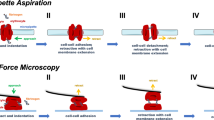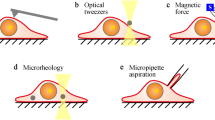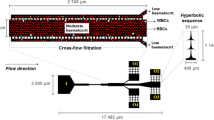Abstract
The simultaneous determination of adhesion and deformability parameters of erythrocytes was carried out through a microfluidic device, which uses an inverted optical microscope with new image acquisition and analysis technologies. Also, an update of the models describing erythrocyte adhesion and deformation was proposed. Measurements were carried out with red blood cells suspended in saline solution with human serum albumin at different concentrations. Erythrocytes adhered to a glass surface were subjected to different low shear stress (from 0.04 to 0.25 Pa), causing cellular deformation and dissociation. The maximum value obtained of the erythrocyte deformability index was 0.3, and that of the adhesion energy per unit area was 1.1 × 10−6 Pa m, both according to previous works. The obtained images of RBCs adhered to glass reveal that the adhesion is stronger in a single point of the cell, suggesting a ligand migration that concentrates the adhesion in a “spike-like tip” in the cell. Moreover, adhesion energy results indicate that the energy required to separate erythrocytes in media with a lower albumin concentration is greater. Both results could be explained by the mobility of membrane receptors.





Similar content being viewed by others
References
Mohandas, N., & Gallagher, P. G. (2008). Red cell membrane: past, present, and future. Blood, 112(10), 3939–3948. https://doi.org/10.1182/blood-2008-07-161166.
Evans, E. A., & Skalak, R. (2018). Mechanics and thermodynamics of biomembranes. Boca Raton: CRC Press (pp. 1–254). ISBN 9781351074339.
Riquelme, B. D., Valverde, J., & Rasia, R. J. (1998). Complex viscoelasticity of normal and lectin treated erythrocytes using laser diffractometry. Biorheology, 35(4-5), 325–334. https://doi.org/10.1016/S0006-355X(99)80014-6.
Castellini, H. V., & Riquelme, B. D. (2018). Study of non-linear viscoelastic behavior of the human red blood cell. Quantitative Biology. https://arxiv.org/abs/1810.07760.
Sans-Sabrafen, J., Besses Raebel, C., & Vives Corrons, J. L. (2006). Hematología clínica. Quinta Ed. Madrid: Elsevier. ISBN 9788481747799.
Meiselman, H., Neu, B., Rampling, M., & Baskurt, O. (2007). RBC aggregation: laboratory data and models. Indian Journal of Experimental Biology, 45(1), 9–17.
Lebensohn, N., Re, A., Carrera, L., Barberena, L., D´Arrigo, M., & Foresto, P. (2009). Ácido siálico sérico, carga aniónica y agregación eritrocitaria en pacientes diabéticos e hipertensos. Medicina, 69(3), 331–334.
Skalak, R., Zarda, P. R., Jan, K. M., & Chien, S. (1981). Mechanics of rouleau formation. Biophysical Journal, 35(3), 771–781. https://doi.org/10.1016/s0006-3495(81)84826-6.
Waugh, R. E., & Hochmuth, R. M. (2014). Mechanics and deformability of hematocytes. In Peterson, D. R., Bronzino, J. D. (Eds), Biomechanics: principles and practices. Boca Raton: CRC Press (pp. 14-1–14-14). ISBN 9780429110832.
Renoux, C., Faivre, M., Bessaa, A., Da Costa, L., Joly, P., & Gauthier, A., et al. (2019). Impact of surface-area-to-volume ratio, internal viscosity and membrane viscoelasticity on red blood cell deformability measured in isotonic condition. Scientific Reports, 9(1), 1–7. https://doi.org/10.1038/s41598-019-43200-y.
Gratzer, W. B. (1981). The red cell membrane and its cytoskeleton. The Biochemical Journal, 198(1), 1–8. https://doi.org/10.1042/bj1980001.
Rasia, R. J. (1995). Quantitative evaluation of erythrocyte viscoelastic properties from diffractometric data: applications to Hereditary spherocytosis and hemoglobinopathies. Clinical Hemorheology and Microcirculation, 15(2), 177–189. https://doi.org/10.3233/CH-1995-15205.
Kaliviotis, E., Ivanov, I., Antonova, N., & Yianneskis, M. (2010). Erythrocyte aggregation at non-steady flow conditions: a comparison of characteristics measured with electrorheology and image analysis. Clinical Hemorheology and Microcirculation, 44(1), 43–54. https://doi.org/10.3233/CH-2009-1251.
D’Arrigo, M., Riquelme, B. D., Valverde, J., & Foresto, P. (2009). Análisis de la energía de adhesión intercambiada en la unión CD44-hialuronato. e-Universitas UNR Journal, 1(2), 305–312.
Toderi, M. A., Castellini, H. V., & Riquelme, B. D. (2017). Descriptive parameters of the erythrocyte aggregation phenomenon using a laser transmission optical chip. Journal of Biomedical Optics, 22(1), 17003. https://doi.org/10.1117/1.JBO.22.1.017003.
Toderi, M. A., Riquelme, B. D., & Galizzi, G. E. (2020). An experimental approach to study the red blood cell dynamics in a capillary tube by biospeckle laser. Optics and Lasers in Engineering, 127, 105943. https://doi.org/10.1016/j.optlaseng.2019.105943.
Baskurt, O. K., Hardeman, M. R., Rampling, M. W., & Meiselman, H. J. (2007). Handbook of hemorheology and hemodynamics. 1st ed. Amsterdam: IOS Press. ISBN 9781607502630.
Riquelme, B. D., & Londero, C. M. (2018). New optical approach to simultaneous determination of deformability and adhesion energy of human erythrocytes. Optics InfoBase Conference Papers, Part F123-LAOP 2018. https://doi.org/10.1364/LAOP.2018.Th4A.39.
Alapan, Y., Little, J. A., & Gurkan, U. A. (2014). Heterogeneous red blood cell adhesion and deformability in sickle cell disease. Scientific Reports, 4, 7173. https://doi.org/10.1038/srep07173.
Eriksson, L. E. (1990). On the shape of human red blood cells interacting with flat artificial surfaces—the “glass effect”. Biochimica et Biophysica Acta, 1036(3), 193–201. https://doi.org/10.1016/0304-4165(90)90034-t.
Skalak, R. (1973). Modelling the mechanical behavior of red blood cells. Biorheology, 10(2), 229–238. https://doi.org/10.3233/BIR-1973-10215.
Evans, E. A. (2018). Mechanics of cell deformation and cell-surface adhesion. In Bongrand, P. (Ed.), Physical basis of cell-cell adhesion. (pp. 91–124). Boca Raton: CRC Press. eBook ISBN 9781351075572.
Bennett, S. J., Devries, K. L., & Williams, M. L. (1974). Adhesive fracture mechanics. International Journal of Fracture, 10, 33–43. https://doi.org/10.1007/BF00955077.
Skalak, R., & Chien, S. (1983). Theoretical models of rouleau formation and disaggregation. Annals of the New York Academy of Sciences, 416(1), 138–148. https://doi.org/10.1111/j.1749-6632.1983.tb35184.x.
Skalak, R., & Zhu, C. (1990). Rheological aspects of red blood cell aggregation. Biorheology, 27(3–4), 309–325. https://doi.org/10.3233/BIR-1990-273-409.
Sung, L. A., Kabat, E. A., & Chien, S. (1985). Interaction energies in lectin-induced erythrocyte aggregation. Journal of Cell Biology, 101(2), 652–659. https://doi.org/10.1083/jcb.101.2.652.
Londero, C. M., D’Arrigo, M., & Riquelme, B. D. (2016). Optimización del medio de suspensión para la observación de glóbulos rojos humanos frescos con microscopios ópticos. Acta Microscópica, 25(3), 151–156.
Ponder, E. H. (1971). Hemolysis and related phenomena. 2nd Ed. New York: Grune & Stratton. ISBN 9780808906728.
Wong, P. (2005). A hypothesis of the disc-sphere transformation of the erythrocytes between glass surfaces and of related observations. Journal of Theoretical Biology, 233(1), 127–135. https://doi.org/10.1016/j.jtbi.2004.09.013.
Danieli, V., D’Arrigo, M., & Riquelme, B. D. (2009). Deformability of adhered cells study by means of digital microscopic images. Acta Microscópica, 18(3), 261–268.
Hochmuth, R. M., Mohandas, N., & Blackshear, Jr., P. L. (1973). Measurement of the elastic modulus for red cell membrane, using a fluid mechanical technique. Biophysical Journal, 13, 747–762. https://doi.org/10.1016/S0006-3495(73)86021-7.
DiMilla, P. A., Barbee, K., & Lauffenburger, D. A. (1991). Mathematical model for the effects of adhesion and mechanics on cell migration speed. Biophysical Journal, 60(1), 15–37. https://doi.org/10.1016/S0006-3495(91)82027-6.
Rubinson, K. A., & Baker, P. F. (1979). The flow properties of axoplasm in a defined chemical environment: influence of anions and calcium. Proceedings of the Royal Society B: Biological Sciences, 205(1160), 323–345. https://doi.org/10.1098/rspb.1979.0068.
Amaiden, M. R., Monesterolo, N. E., Santander, V. S., Campetelli, A. N., Arce, C. A., Pie, J., Hope, S. I., Vatta, M. S., & Casale, C. H. (2012). Involvement of membrane tubulin in erythrocyte deformability and blood pressure. Journal of Hypertension, 30(7), 1414–1422. https://doi.org/10.1097/HJH.0b013e328353b19a.
Sackmann, E., & Smith, A. S. (2014). Physics of cell adhesion: some lessons from cell-mimetic systems. Soft Matter, 10(11), 1644–1659. https://doi.org/10.1039/c3sm51910d.
Acknowledgements
The authors would like to thank Dr. Mabel D’Arrigo for performing the blood draws and Dr. Analía I. Alet and the staff from the English Department of the Facultad de Ciencias Bioquímicas y Farmacéuticas (UNR) for the language correction of the manuscript. C.M.L. would also like to thank the “Nuevo Banco de Santa Fe” for the Technological Innovation Scholarship received to carry out a previous optimization and validation of the microfluidic chamber used in this work.
Funding
This study was funded by the National University of Rosario.
Author information
Authors and Affiliations
Corresponding author
Ethics declarations
Conflict of Interest
The authors declare that they have no conflict of interest.
Additional information
Publisher’s note Springer Nature remains neutral with regard to jurisdictional claims in published maps and institutional affiliations.
Rights and permissions
About this article
Cite this article
Londero, C.M., Riquelme, B.D. Simultaneous Determination of Human Erythrocyte Deformability and Adhesion Energy: A Novel Approach Using a Microfluidic Chamber and the “Glass Effect”. Cell Biochem Biophys 79, 49–55 (2021). https://doi.org/10.1007/s12013-020-00956-9
Accepted:
Published:
Issue Date:
DOI: https://doi.org/10.1007/s12013-020-00956-9




